Hiking to Ijen Crater in Java – An Unforgettable Adventure
It was 11:30 PM when the alarm jolted us awake, barely two hours into our sleep. Back home in India, this would normally be our bedtime, but we dragged ourselves from the comfort of our bed to embark on the adventure of a lifetime. It was time to head to Kawah Ijen, a long-time dream destination. With its turquoise blue crater lake, the famed Blue Fire, and the fact that Ijen is still an active volcano, it was everything our curious souls had been longing for.
Read on to know more about this epic place and our unforgettable adventure.
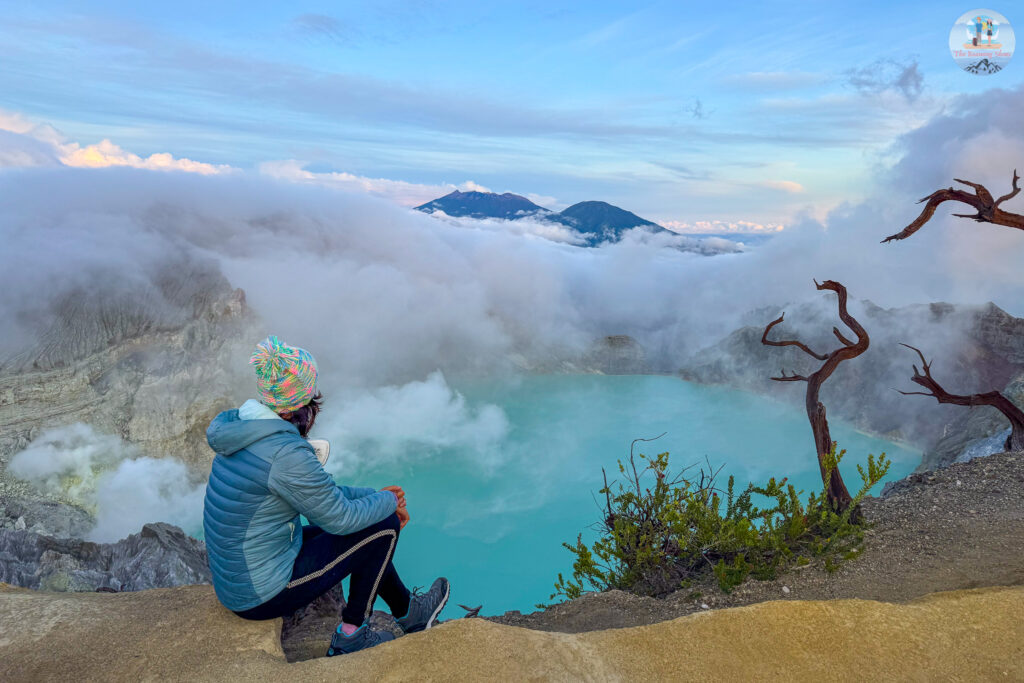
A Little About Mount Ijen
Mount Ijen (pronounced ee-jen), located in East Java, Indonesia, is an active volcano that is part of the Ijen UNESCO Global Geopark. It is home to one of the most acidic crater lakes in the world, with an enchanting turquoise colour.
This remarkable site also features the rare and mesmerising blue fire phenomenon, believed to be one of the only two places on Earth where it can be observed. The blue flames result from sulphuric gases emerging from volcanic fissures, igniting upon contact with atmospheric oxygen. The entire volcanic landscape of the Ijen region is otherworldly, and an absolute must-visit.
Ijen is also alternately addressed as Kawah Ijen, Mount Ijen, Ijen Lake, Ijen Crater Lake, Ijen Volcano, Ijen Plateau etc. by many people as well as tour agencies. But at the end, they are all referring to the same place.
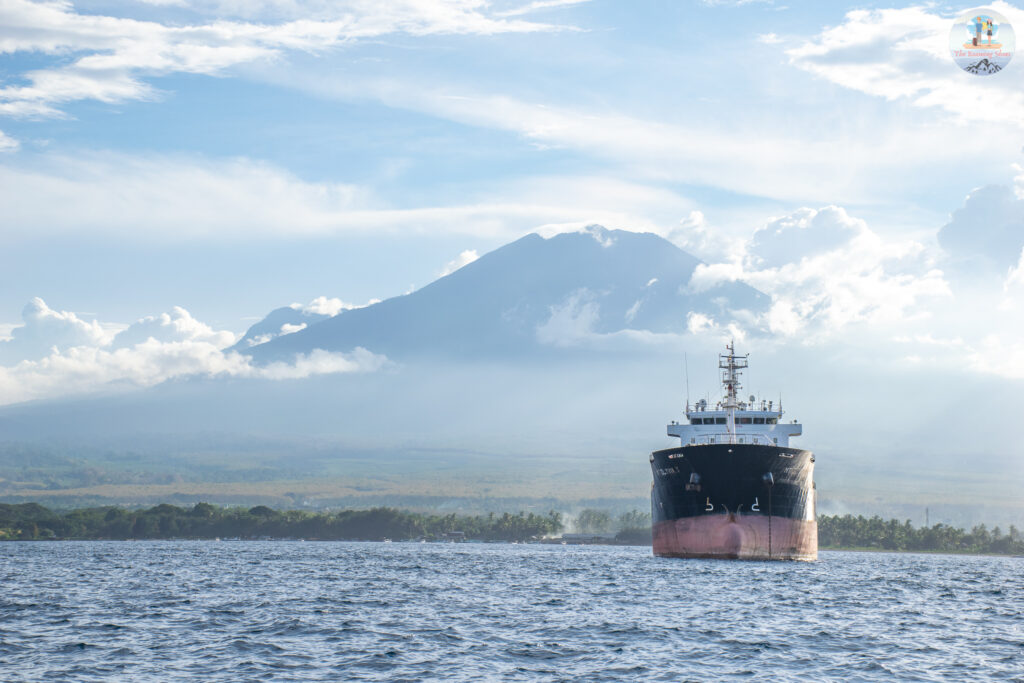
Choosing a Base for Mount Ijen Tour
Banyuwangi is the closest and the most popular base for Ijen tour. From Banyuwangi, it is approximately 1-1.5 hours of drive to reach the base of Mount Ijen, making it an ideal starting point for the early morning trek. But this is not the only reason why we chose Banyuwangi.
- Ample Stay options: There are many hotels and home stays in Banyuwangi for different budget ranges.
- Good Connectivity: Banyuwangi has excellent connectivity, featuring a major train station and an airport with domestic flights to key cities like Jakarta and Surabaya. Additionally, the city’s port makes it a convenient gateway to Bali, with regular ferry services.
- Good restaurants and varied food options: Plenty of cafes and restaurants in Banyuwangi offering a wide range of options, from Western food to local dishes. Also, its warungs (local eateries) and bustling street food scene are perfect for sampling authentic Indonesian flavours.
- Local Attractions and Day Trips: While Ijen is the primary attraction, the charming sea side town of Banyuwangi has much more to offer. It has a lovely waterfall (Jagir Waterfall) and some beautiful beaches (Wata Doodle, Pulau Merah etc.) to unwind at after an adventure.
Banyuwangi is also a great base for exploring West Bali National Park.
Bondowoso offers an alternative to Banyuwangi, although the drive is a little longer to Mount Ijen. Also, in terms of connectivity and accommodation options, Banyuwangi is more convenient. But if you do not mind being a little farther from town and prefer mountain, villages and scenic routes, then Bondowoso is a good option.
How to Visit Mount Ijen
Group or Open Tour
The best way is to visit Ijen is by joining an open tour where the operator takes care of everything. They will pick you up from your stay, provide you with gas masks and head lamps, guide you on the hike and then drop you off back at your accommodation. They also take care of the entrance fees for the park. So all you need to do is pay the money, and then relax and enjoy the beauty of this unconventional destination.
The tour mainly has 3 major highlights,
- Witnessing the famous blue fire inside the crater
- Watching Sunrise from the Sunrise point on the crater rim
- Enjoying views of the stunning Ijen crater lake
Cost of the tour
350,000 IDR per person (This is what we paid which seemed to be the standard rate. Not sure if it could come down any further)
Inclusions
- Park fee
- Pick up and drop from accommodation
- Guide for the hike
- Head lamp and gas mask
- A little snack (fried banana) after coming back from the hike
Exclusions
- Health Check fee: 35000 IDR
- Any food or drinks you buy
Our tour was arranged by our accommodation in Banyuwangi. But you can also book this tour yourself by connecting with any reputed travel company.
Our take on the tour
Our tour went well without any major issues. The vehicle provided was good as well as the guides. We had 2 guides for a group of ~10 people. The guide at the back of the group was a very nice person, keeping patience with our slow climb and assisting us all the way. His stories and singing ( a Shahrukh Khan fan 😀 ) made our trip much easier and enjoyable.
Private Tour or Visiting Independently
A private tour is more suitable for people who want flexibility and do not want to be bound by the group’s pace or timings. Some people also do the trip on their own without booking a tour. I am not sure though how much of a difference it makes in terms of money. If you are opting for the latter, please keep the following in mind.
- Avoid Bike: Opt for a car instead of a bike for travelling to Ijen. The hilly road without any lights is not exactly suitable for a bike ride, especially when the cars drive very fast on that road. And not sleeping much before the trip does not help too.
- Stay Vigilant: If you’re taking a car to Ijen, it’s important to stay vigilant and engage with the driver periodically. There have been reports of drivers dozing off during the journey. We do not want that, do we 🙂 ? Remember, they are human too and the odd hours of sleep and driving can easily take a toll on anybody.
- Entry Ticket: You need to buy the entry ticket to the park online (link:https://tiket.bbksdajatim.org/#/) by paying the entrance fee (100.000 IDR (6 USD) on weekdays and 150.000 IDR (10 USD) for weekends).
- Health Certificate: Health certificate is mandatory for visiting Ijen. This can be acquired at any medical centre by paying the required charges. You can talk to your accommodation for guidance.
- Guide: Take a guide. First of all, they are very well aware of the terrain and can help navigating in the dark. The descent into the crater is particularly tricky, with a narrow, rock-strewn path that requires careful manoeuvring. I literally climbed down the whole time holding on to our guide. And also met people on the way who went without a guide and were struggling. Other than the safety aspect, a guide can also provide insight in to the area’s geology and history and can even help time your tour so that you don’t miss on anything.
Ijen Hike – Difficulty Level and Detailed Breakdown with Time
Okay, I will be brutally honest here. Mount Ijen hike is not as easy as claimed by some people. It definitely challenges both your body and the mind. Based on our experience, I will rate it as moderate, if not very difficult.
The hiking trail to Ijen is relatively straightforward and follows a paved road up to the crater rim. However, the path is quite steep for much of the way, and tackling it in the dark, especially after a sleepless night, makes it even more challenging. It’s normal to find yourself out of breath every now and then. My advice is to take it slow, take breaks, and pace yourself—you’ll be fine. For those who are regular hikers or maintain an active lifestyle, the climb might seem less daunting. Interestingly, there was this girl from The Netherlands in our group who said it was her first hike. And she was doing much better than us who proudly said they had prior experience of hiking in the mountains 😀 .
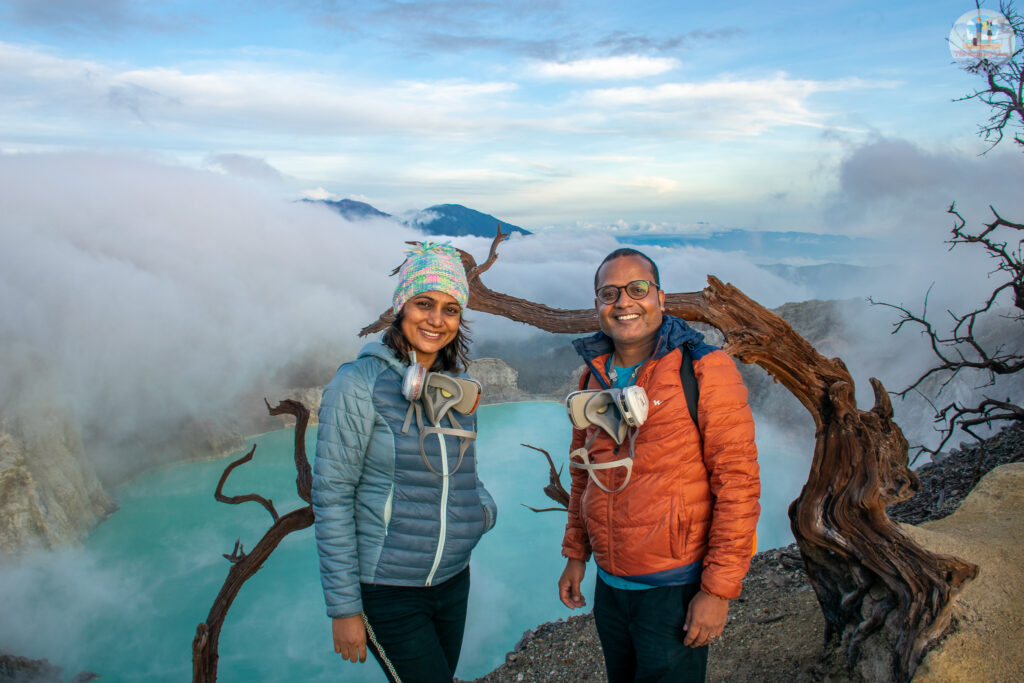
Now, let’s talk about the 2nd part, the climb down in to the crater. This is the part where you have to be very careful of each step as the descent in to the crater is through a narrow rocky path. Also, this same path is used by both people going down and coming up, making it even more difficult. I was a bit scared to climb down this path, but thanks to our guide, I was able to make it in to the crater safely. Having a shoe with good grip just felt like a blessing. The hike back from the crater to the rim felt much easier than the descent.
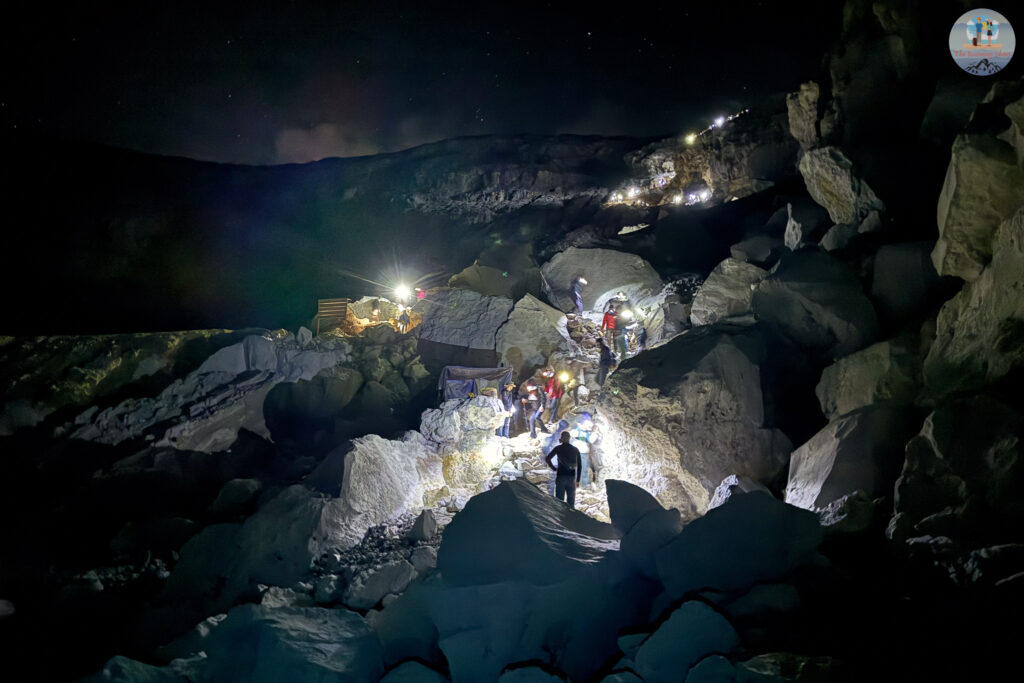
The third part is the descent back from the crater rim to the parking lot. While walking up, we thought the descent must be easier. But it literally tested our knees and we had to watch our step carefully as the ground had become wet after a little rain. Again, this is where I was so happy about buying a good pair of hiking shoes.
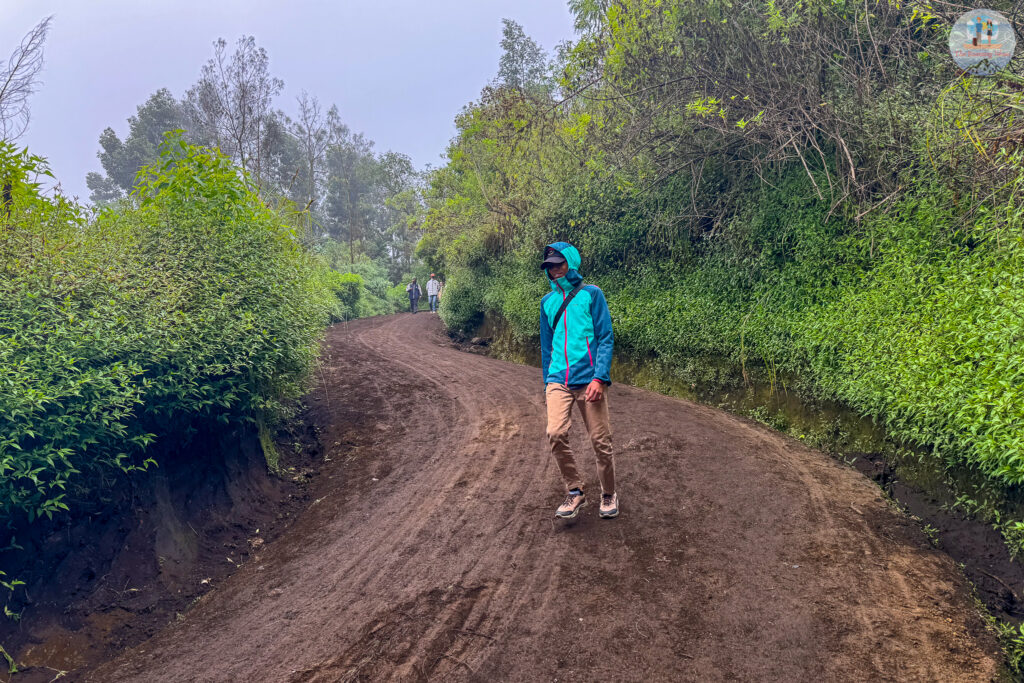
Time needed for the hike
Here is a rough estimate of the time needed for various parts of this journey.
| Crater rim ascent | Climbing up to the crater rim from entry gate | ~ 1.5 hours |
| Blue Fire Descent | Descend in to the caldera from crater rim for blue fire | ~ 45 mins |
| Caldera to Crater rim accent | Climbing up from the caldera to the crater rim | ~ 30-40 mins |
| Return Descent | Hike back from crater rim to parking | ~ 1 hour |
The Alternate Option to hiking
There are these hand-pushed (or pulled) wheelbarrows operated by locals to ferry people up and down the mountain. And we saw a lot of people using these on the way back from the summit. Looking at the effort that goes into this, the prices looked quite reasonable. Also, this provides a source of income to the locals, especially the ex-miners. So feel free to use their services if you are up for it.
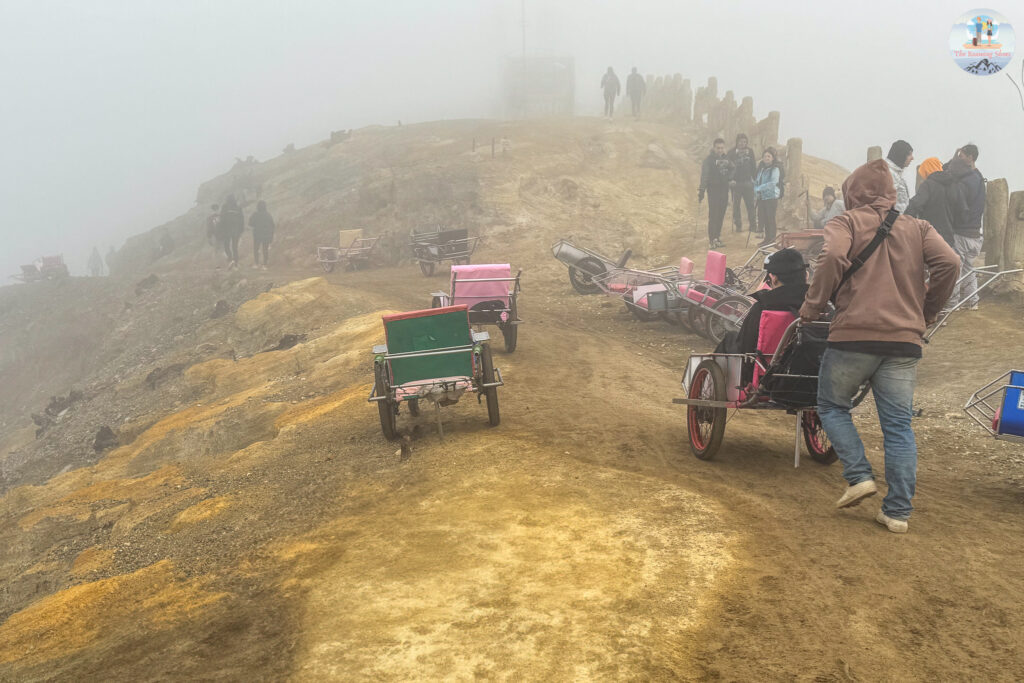
The Tour and the Experience
We were picked up from our accommodation at midnight, joining a few other travellers in the vehicle. Few minutes in to the drive, we stopped at a medical centre to obtain the health certificate that is mandatory for visiting Ijen. The process was straightforward: they checked our blood pressure and oxygen levels and asked if we had asthma. Then we paid 35000 IDR per person and were cleared to go ahead. The rest of the journey was pretty uneventful, with us alternating between trying to sleep and appreciating the dark surroundings.
Arrival and Preparation
After about an hour, our vehicle stopped in front of a line of small shop-cum-eateries. We had arrived at the parking lot at the base of Kawah Ijen. The night air was chilly, a stark contrast to the warmth of Banyuwangi, prompting us to quickly don our warm jackets and beanies. We were then led into one of the eateries where we met our guides and fellow hikers.
Some hot tea and Kue Kus (thanks to our hosts for packing these) in the warmth of the shop and we were ready for the adventure. The tour guys provided gas masks and head lamps to everyone. And after a little briefing, all of us headed to our destination, Mount Ijen.
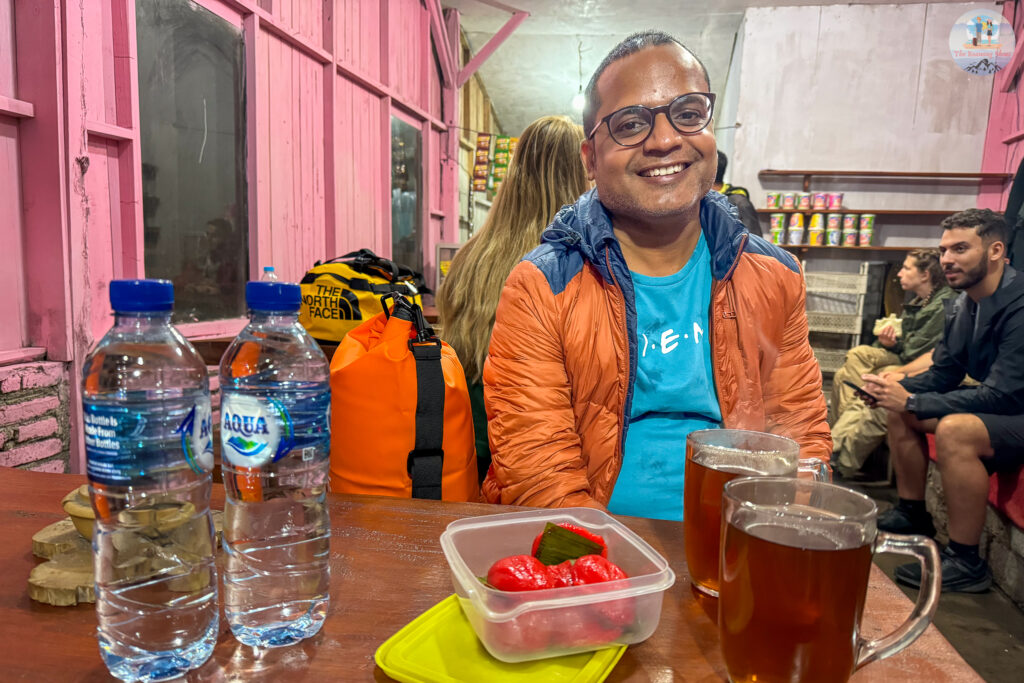
The Hike and the Experience
We started our hike around 2 am, with our guides at both ends of the group. We tried maintaining a brisk pace, staying at the rear end of the group and taking small breaks every few minutes. The steep path made it feel like scaling a wall in complete darkness, with our headlights casting small beams of light. Yet, each glance at the star-filled sky replaced our fatigue with wonder and newfound energy, while the surreal night views of the mountains and clouds simply added to the magic.
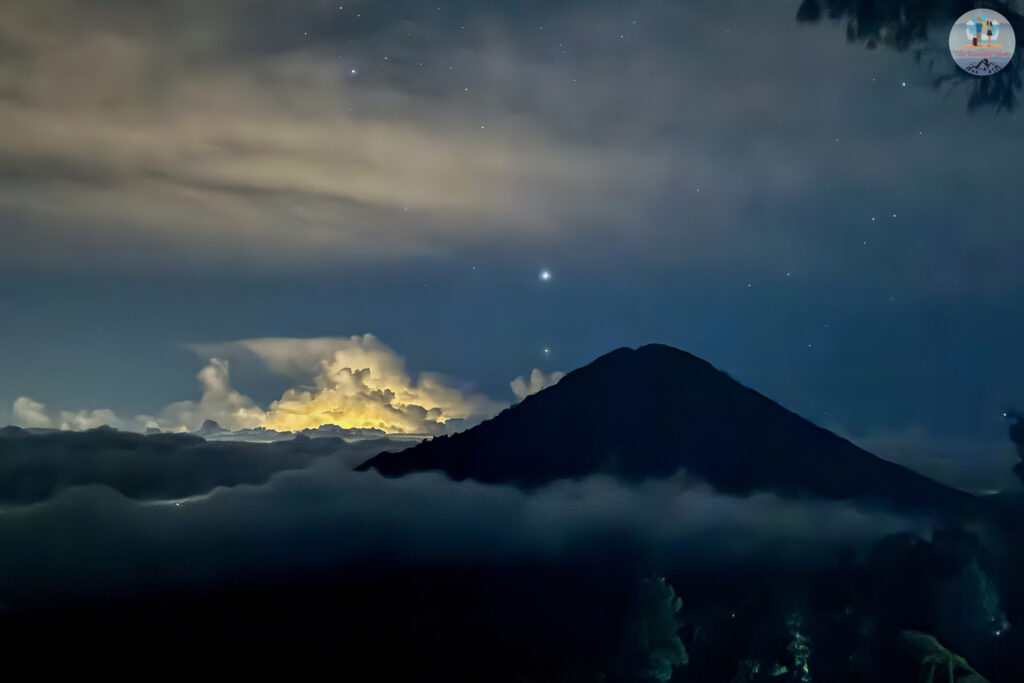
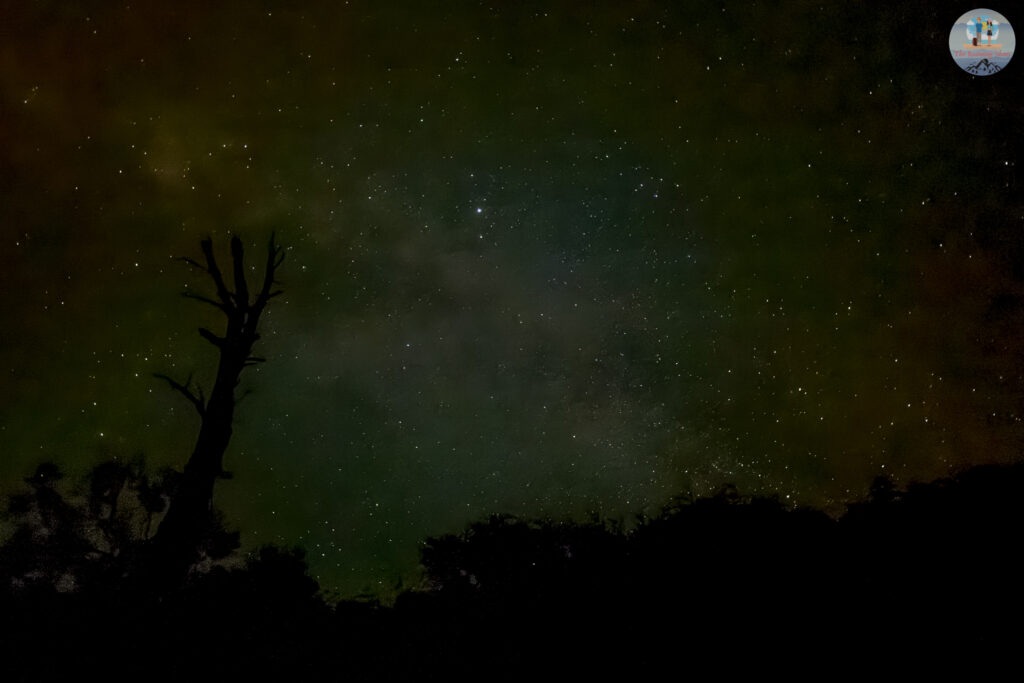
On reaching the crater’s rim, we descended into the caldera, anticipation building to witness the blue fire. The strong smell of sulphur grew as we approached, and thick smoke became visible at a distance. We donned our gas masks, but the intense sulphur smoke still burned our eyes as we got closer. Our guide advised us to close our eyes and turn away until the wind shifted.
Finally we got a little window when the wind changed direction and our guide led us closer to see the famed blue fire. And OMG! What an incredible sight it was! The blue fire looked more like Blue Lava flowing through the cracks, glowing in the dark. We could not stand there longer to let other people have a chance too and also it was difficult to keep our burning eyes open. But I knew in that moment, all the pain taken to reach there was absolutely worth for those few minutes of witnessing this wonder.
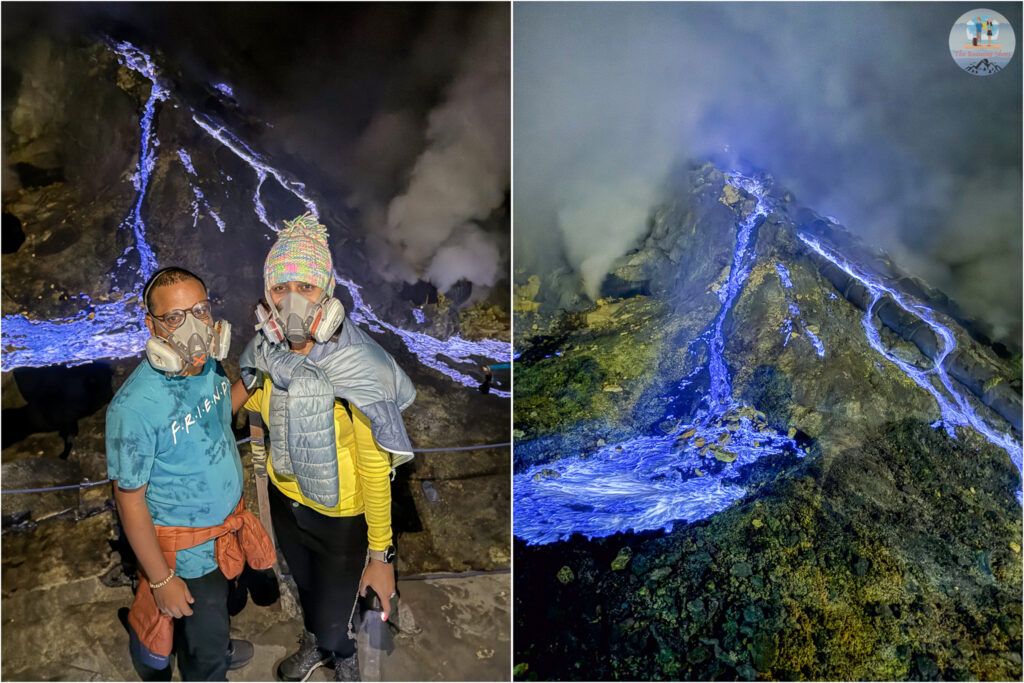
As dawn approached, we began our ascent back to the crater rim for sunrise. The climb felt easier than the way down, and we soon found ourselves at the rim. There, we caught the first glimpse of the lake nestled in the crater, its bluish hue contrasting starkly with the dimly lit surroundings. While most of the people hurried to the sunrise point ahead, we chose to linger near the dead trees, which gave the landscape an otherworldly feel. I now understood why this spot appeared so frequently in photos of Ijen Crater Lake online.
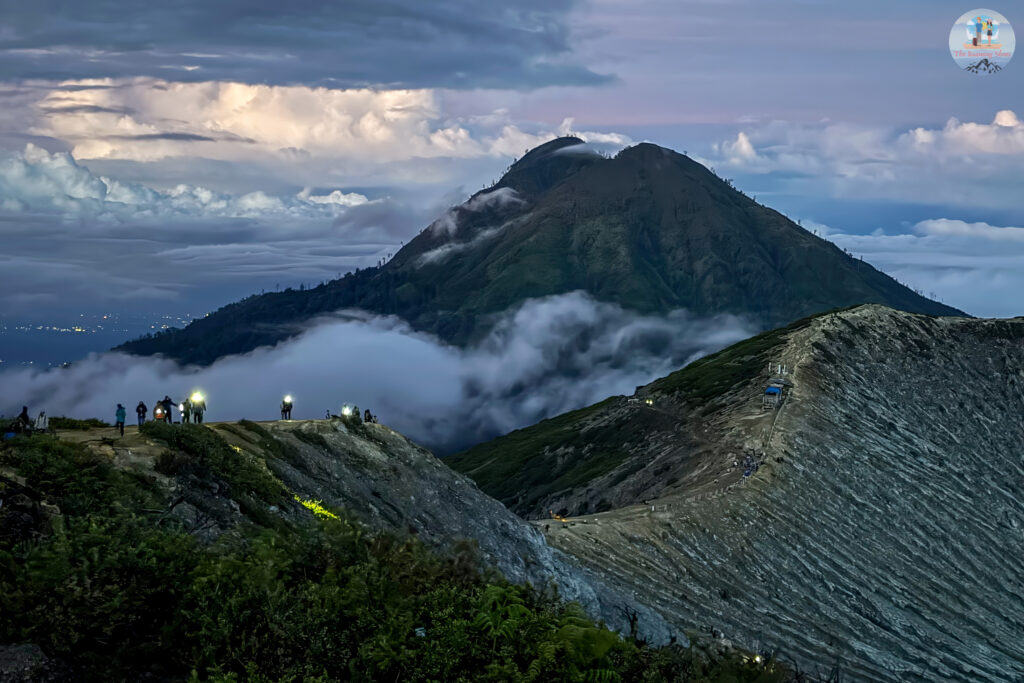
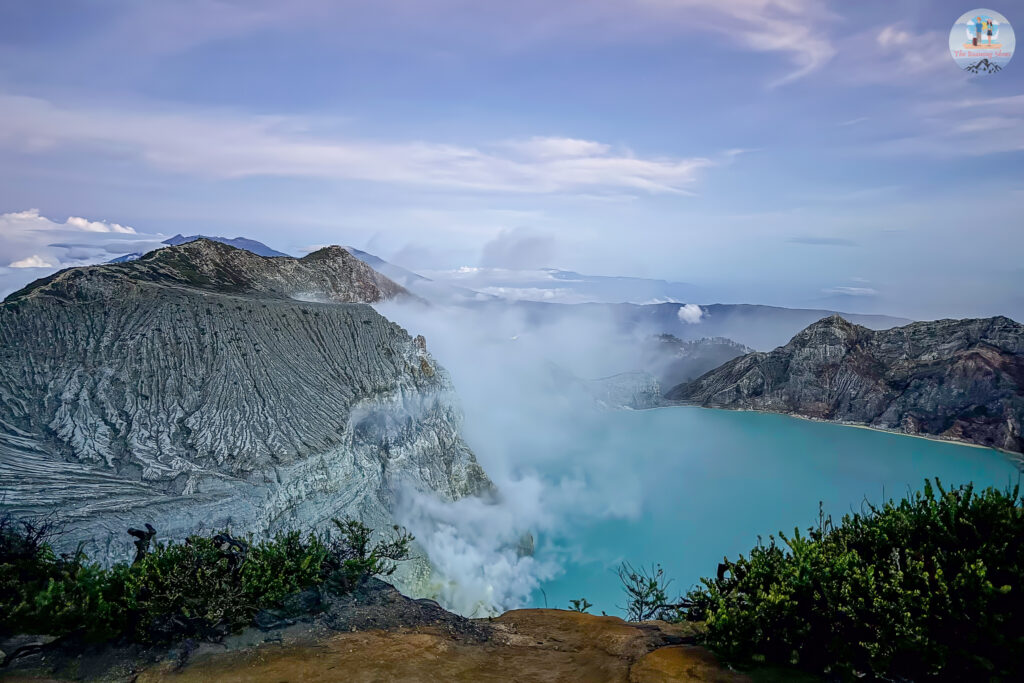
Opposite the lake, the sky had begun to blush with the colours of sunrise over a lush green landscape. Above the lake, the scene was partially veiled by clouds and smoke under a soft orange sky. As the morning light shone, the lake transformed into a mesmerising shade of turquoise, with sulphur smoke curling from one side. It was astonishing to think we had been so close to this wonder during our night descent, yet had missed it entirely in the darkness.
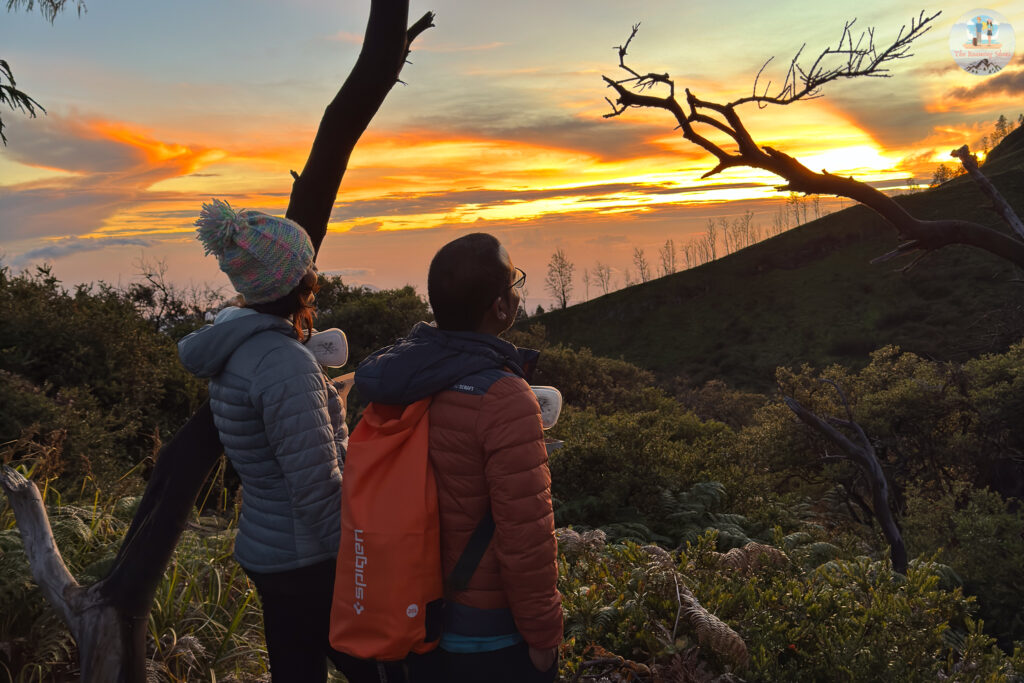
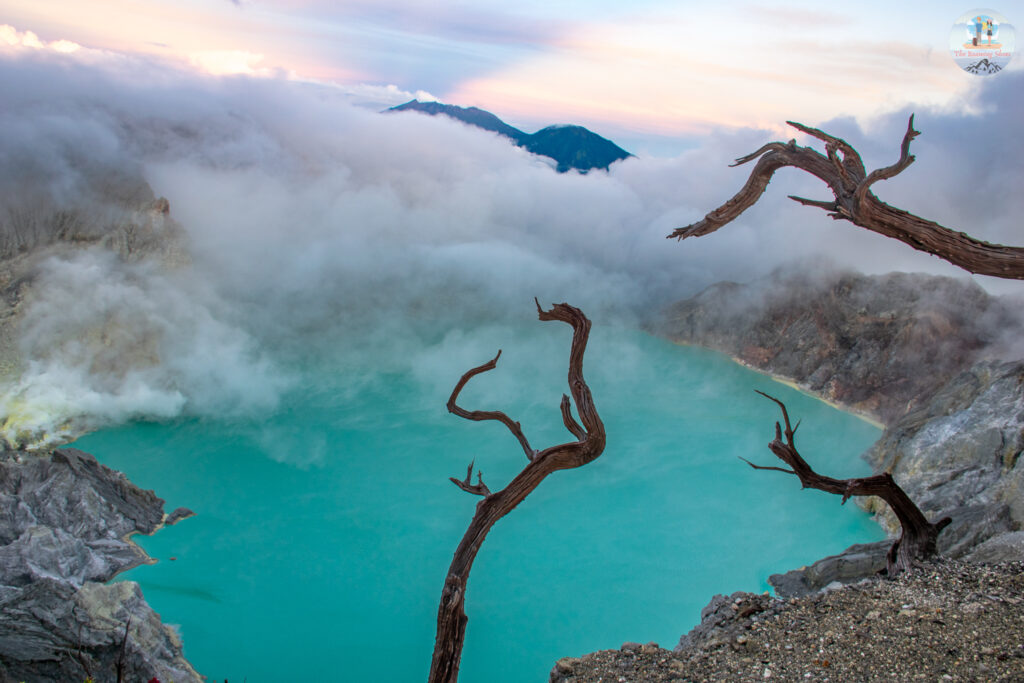
There was something about this crater lake, as if it held a hypnotic power. Staring at it, it felt as though time had paused, and nothing else existed but the scene before us. There was this overwhelming emotion welled up inside, of gratitude, wonder, joy and so much more.
The Journey Back
Shortly after sunrise, mist began to envelop the area, slowly obscuring the lake with a veil of smoke. The surroundings took on a Jurassic Park-like aura, shrouded in mystery. We started our hike back to the base again, this time our knees taking the brunt of the steep descent, and by this time we were exhausted. The only solace was the opportunity to savour the lush scenery we had missed in the darkness on the way up.
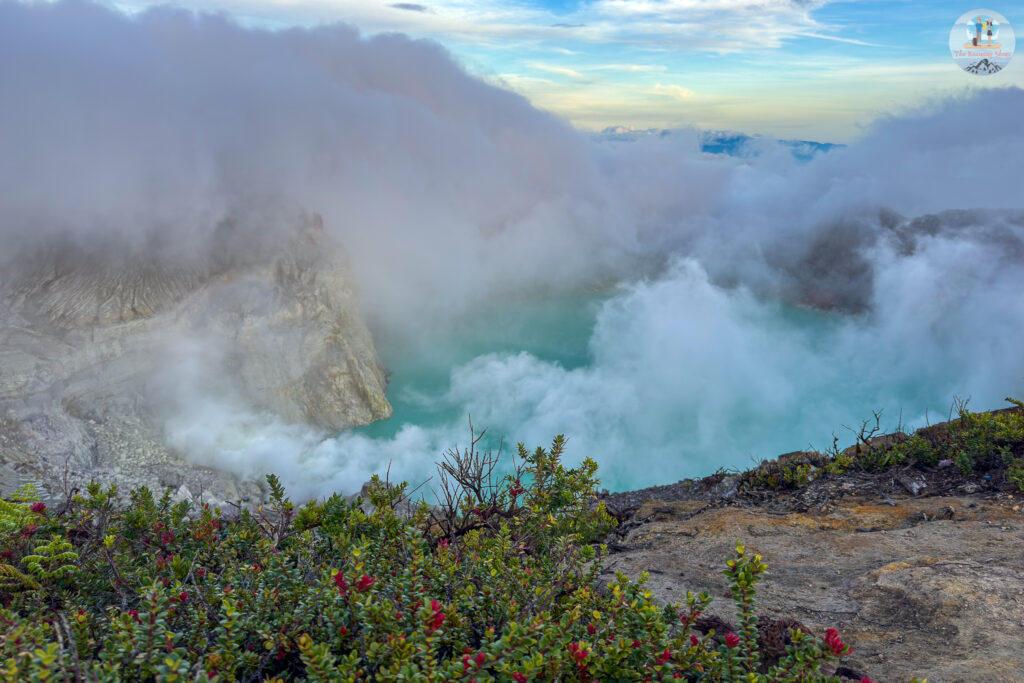
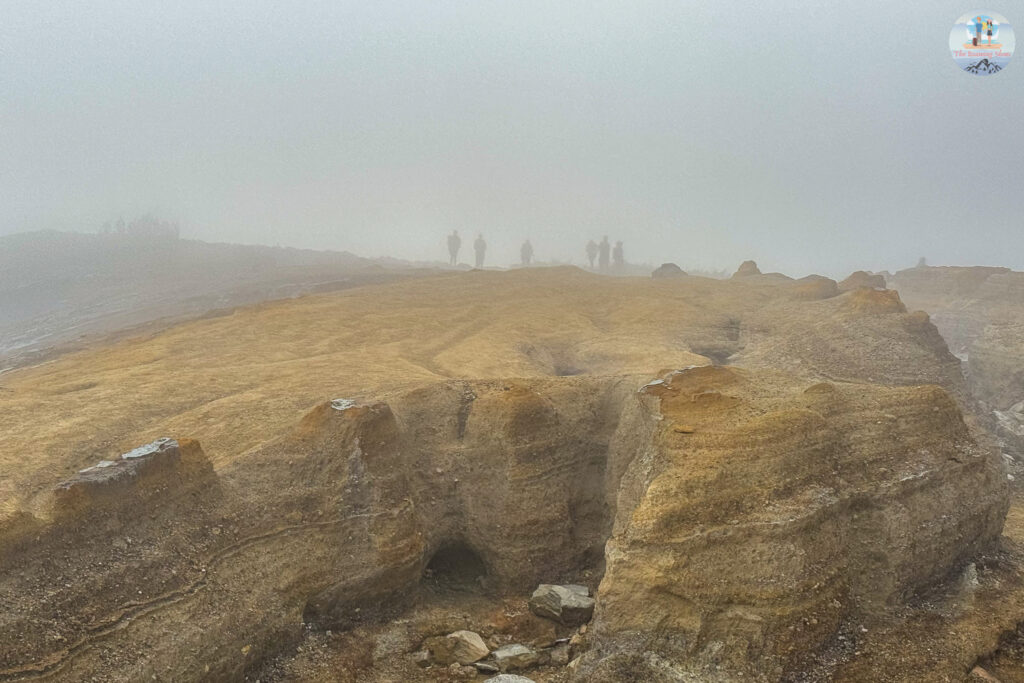
Back at the parking lot, hot banana fries awaited us, and our ravenous stomachs were more than happy for the sweet treat. It was hard to believe we had completed this trek, something we had long dreamed of. As we headed back to Banyuwangi, everyone in the car quickly fell asleep, but my eyes stayed wide open, savouring the beautiful forest we passed. And I realised in that half-awake state, Ijen was never just about the blue flames or the lake or even the sunrise – It is the journey and the experiences, that makes this place so unique and enticing.
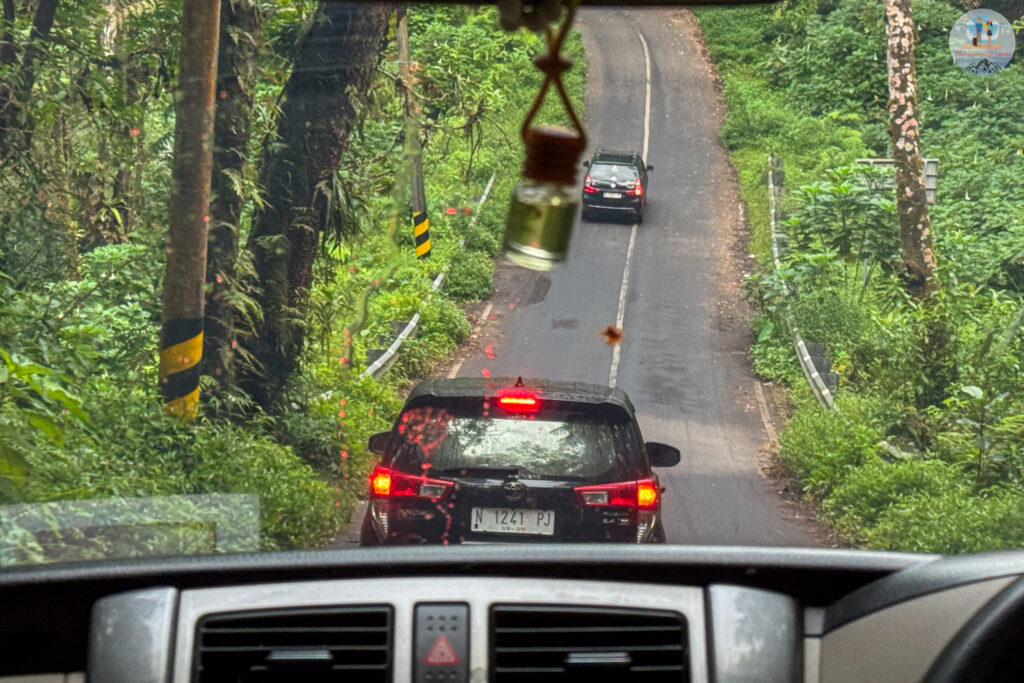
Things you need for the hike
- Good hiking pants or tights – Opt for comfortable hiking pants or tights that offer flexibility and warmth. It makes the ascent so much easier on the steep path. Pair it with a shirt or t-shirt. Avoid jeans.
- Hiking shoes with good grip – A must for both the descent into the crater and the return hike, as the continuous steep terrain demands reliable traction.
- A good Windproof Jacket – Ijen is quite cold at night. You may not need the jacket after you start hiking, but the moment you are back at the crater rim towards dawn, it feels super cold, specially because of the wind.
- A beanie to keep you warm
- Headlamp (With batteries to last at least 3-4 hours)- The tour operators provide head lamps. But theirs is so used, sometimes it goes off in the middle of the hike.
- Light snack or protein bars – Carry some protein bars to replenish your energy during the hike.
- A bottle of drinking water – Not required if you are taking a tour. They normally provide water.
- Emergency medicines
- Camera gears
- Waterproof hiking bag or a bag with rain cover to keep your belongings safe
- Indonesian currency in cash – For any tips or food and drinks, as cash is the only accepted payment method in these places.
The Other Side of Kawah Ijen – Life of Sulphur Miners
Ijen Crater may be a bucket list experience for many like us. But in the shadow of this insanely beautiful place lies the world of Sulphur miners who work in a hazardous environment for very little money. This is a place where we could not stay longer than a few minutes due to breathing difficulties (even with gas masks) and burning eyes. And these miners work relentlessly in such environment carrying heavy weights of Sulphur chunks on their shoulders over the steep and dangerous path all the way up.
Sadly, Sulphur does not sell at a very high price and so, these people have to make at least 2-3 trips everyday to earn just enough. One consolation is now they don’t have to climb down the hill with all the weight like before. Rather they use the barrow wheels to ferry the sulphur down once they reach the crater rim. So if you thought your job was difficult, then think about these people who have one of the toughest jobs there is.
We got to know from the guides that almost three fourth of the local population used to work as Sulphur miners in the past. Now the number has reduced to less than 50 as more opportunities for alternate income have opened up with growing tourism in the region. Ex-miners who have picked up a bit of English now work as tour guides, our guide being one of them. And many of them operate the hand operated wagons to ferry people to and from the mountain. So if you feel worn out after the hike, feel free to use the barrow wheels on your way back.
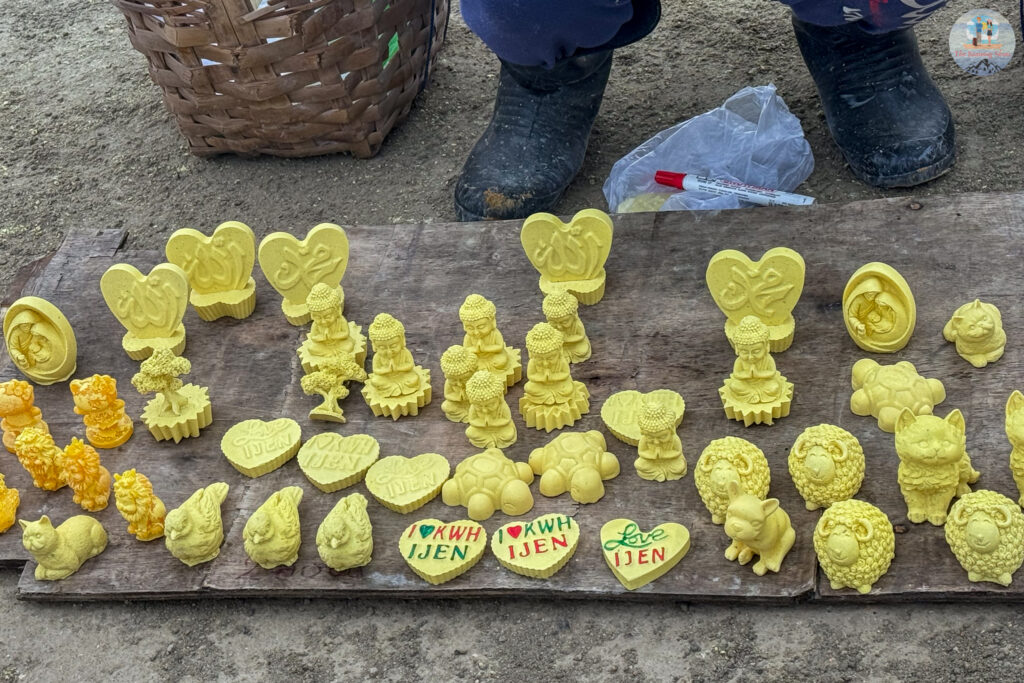
Know before you go
- Health Check and Asthmatics: Health Certificate is mandatory for anyone visiting Ijen since January 2024. This is to ensure you are fit and in good physical condition to visit. And anyone with asthma is not allowed.
- Park Closure Info: Ijen is closed on the first Friday of each month. Additionally, the park may be temporarily closed if volcanic activity increases. To stay updated on any potential closures and to plan your visit effectively, keep an eye on their official website. The website has an option to translate into English
- Useful Link: We found the Ijen Plateau website very useful. It has all the necessary information on ticketing, park closure as well as other details. Do refer it more more information.
- The Uncertainty of Blue Fire: While the blue fire is the main attraction at Ijen, its visibility is not guaranteed. It heavily depends on the environmental conditions. Some visitors have witnessed a large, spectacular blue flame, while others have seen a smaller, less impressive display. However, regardless of the blue fire’s appearance, there are many other remarkable aspects of Ijen that will make your trip an unforgettable experience.
- Too Many People sometimes: It may sound surprising, but Ijen can get very crowded, especially on weekends and holidays. Even on a Monday when we visited, there were many people. Fortunately, the crater rim is expansive, so it doesn’t feel crowded. However, the descent in to the crater becomes challenging with too many people. Also, with a larger crowd, you may not get a chance to see the blue fire up close.
- Toilet Facilities: There are no toilets available at the top of Ijen. So be sure to take care of your needs before starting the hike.
- Keep your hiking bag as light as possible: A heavy bag literally makes the hike difficult on the steep uphill path. Emergency medicines, water, light snack, camera gear and headlamp or torch batteries and may be a beanie and windproof jacket (if you are not already wearing these) – your carry on backpack should not have more than these.
- Tipping the guide: Tipping is not a mandatory in Java and we did not see the guides asking for it in any way. But we decided to tip our guide as he was very helpful during the whole hike, patiently waiting for us and even guiding me through the uneven climb into the crater. So make your choice depending on your circumstances.
- Do Not take risks: Recently a tourist died trying to take pictures on an old tree over the crater rim. The tree broke and she suffered a fatal fall losing her life. We saw that area cordoned off owing to security reasons. And yet, some tourists were going beyond it or sometimes too close to the edge to take pictures. Remember your life is worth more than social media and selfies. Do not take unnecessary risks.
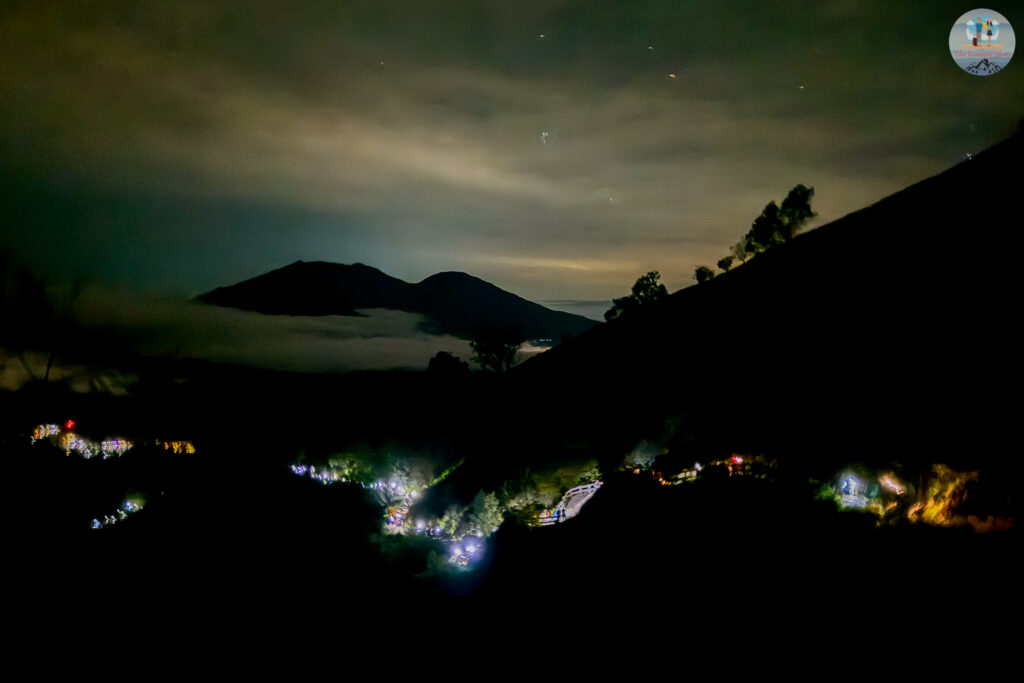
Conclusion
It is true that Ijen is not for everyone. It demands a certain level of fitness and literally tests your determination. But if you persevere, then the whole experience is extraordinarily rewarding.
Ijen was nothing like we had seen before. And even though I had read about it so much, nothing compares to the real experience of being there in person. And now if you ask me, I would say a trip to Java is never complete without visiting Ijen. We hope you get to witness this wonder of nature one day.
Note: All prices mentioned in this blog are effective June 2024
Interested in Java? Read our detailed guides for more information.
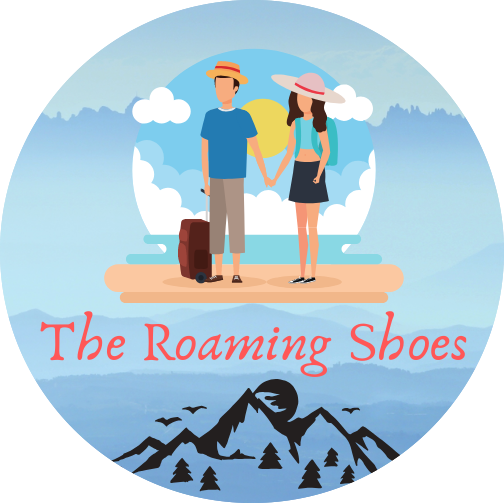


What a useful report! Could you please share the name of the tour company and/or the name of the accommodation in Banyuwangi.who arranged the tour? Many thanks
Hi Barbara,
This trip was arranged by the hosts of our accommodation in Banyuwangi. We had booked the stay through Airbnb. Here is the Airbnb link:
https://www.airbnb.co.in/rooms/707449560537769866?locale=en&_set_bev_on_new_domain=1720855901_EAZjZmMTNjZTI2Y2&source_impression_id=p3_1720855979_P3h4xYvwi0kY3yMw
You can find more details on the accommodation as well as other important information on Java in our Java guide here:
https://theroamingshoes.com/2024/07/experience-the-magic-of-java-indonesia-your-ultimate-travel-guide/
Useful article. Appreciate the details.
Hi Varun,
Thank you for leaving a note. Hope you get to visit Java someday.
Cheers,
Ava and Sush
Brilliant insight into what looks an amazing journey. We are so excited by having read the above but I wonder whether we’ll be able to make it? We’re both in our mid 60’s with desk jobs and have had little time to prepare for this last minute holiday. We’re both determined people so hopefully the lack of preparation won’t stop us for what looks like an experience of a lifetime.
Very informative and to the point guide.
Hello Carol,
Your enthusiasm and determination are genuinely inspiring! While I wouldn’t want to discourage you at all, I do feel it’s important to be honest about the challenges of this hike. As long as there are no major respiratory issues, heart condition or knee/ joint problems, I believe it’s something you can consider with the right mindset and pacing.
Take it slow, consider hiring a local guide, and make sure to get plenty of rest beforehand. And remember, there’s always the option of the hand-pulled “Lamborghinis” if needed.
Wishing you all the best for this adventure. We’d absolutely love to hear how it goes for you.
Cheers,
Ava and Sush
Beautiful write up. Just visited Ijen and yes it’s breathtakingly beautiful.
Hello Roopa,
Happy to hear you could visit Ijen. There is nothing quite like it. And thank you for leaving a note :).
Cheers,
Ava and Sush
Great writeup, thank you. Which month did you visit, I am planning Early July, which other cities did you visit?
Hi Abhishek,
Thank you for your appreciation. We visited Java in June 1st week. You can find the itinerary and all other details in our Java guide:
https://theroamingshoes.com/2024/07/experience-the-magic-of-java-indonesia-your-ultimate-travel-guide/
Have a wonderful trip to Java and do let us know how it goes.
Cheers,
Ava and Sush
I did it last week ..Jun10,2025!! What an amazing experience.
Wow! That’s so good to hear.
Really happy for you.
Cheers,
Ava and Sush
Hello Ava and Sush,
An awesome write-up guys! I am really inspired to visit Ijen. I am planning for the last week of September. Hope I can do it 🙂
BTW, why do you not recommend jeans for the hike?